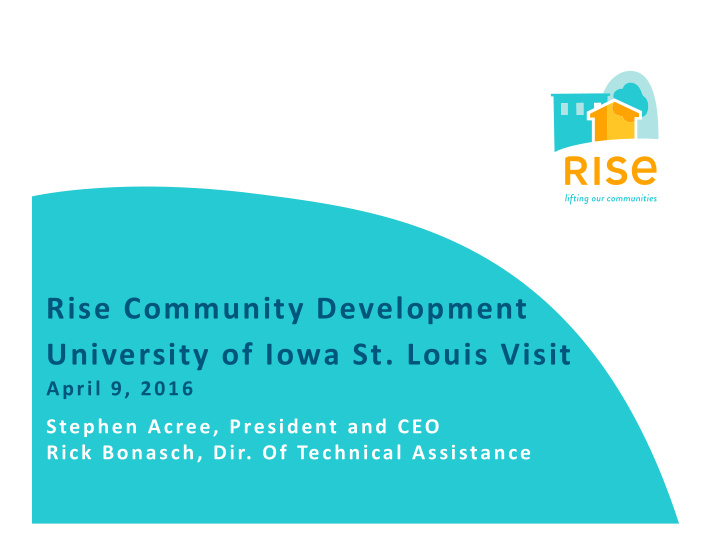



Rise Community Development University of Iowa St. Louis Visit April 9, 2016 Stephen Acree, President and CEO Rick Bonasch, Dir. Of Technical Assistance
APPROACH TO COMMUNITY DEVELOPMENT • Rise uses a community capacity building model to help drive community revitalization. Capacity building activities are data driven and focused based on community and organizational assessments. • Strategy areas include: ― CDC Capacity Building ― Community Capacity Building ― Community Revitalization 2
CDC CAPACITY BUILDING Many of St. Louis’ CDCs have limited staff and financial • capacity. Rise helps expand their capacity through technical assistance and training. Rise technical assistance activities include: ― Board development ― Financial Management ― Organizational Strategic Planning ― Community Engagement ― Project and Program Planning ― Outcome Measurement and Program Evaluation
CDC CAPACITY BUILDING Rise also uses organizational capacity building as a tool • to create more effective, data driven CDC’s. Rise activities include: • Creating maps via GIS • • Providing/interpreting data Working to implement new technology ‐ based tools • Establishing and quantifying performance metrics • 4
COMMUNITY CAPACITY BUILDING • Rise’s Community Capacity Building function creates a catalytic environment in support of community revitalization. Rise technical assistance activities include: • ― Community Assessments ― Neighborhood Planning ― Building Human Capital, Resident Leadership, Increasing Community Engagement ― Historic Preservation ― Outcome Measurement and Program Evaluation
COMMUNITY CAPACITY BUILDING Rise also works with organizations and local • governments in a consulting role. These organizations routinely need to complete Consolidated Plans, CDBG and HOME performance reports, or grant applications. In addition to our expertise in these federal programs, • we can provide demographics and other community and economic statistics utilizing Census data, custom datasets, and other sources as needed. Clients have been the City of St. Louis, counties and • municipalities in the metro area, non ‐ profits, and others. 6
COMMUNITY REVITALIZATION A substantial part of what we do at Rise is real estate • development; mainly with residential developments for households making less than the area median income. • Using GIS data, we are able to better visualize our developments and the areas around them as well as additional data, which may be useful in determining how we move forward with development. This is not only a good internal tool for visualization, • but is often necessary when we seek additional project funding, tax credits, etc. 7
HOW RISE USES DATA • Rise uses data in a variety of ways, both internally and externally, engaging in partnerships with CDCs, government entities, and others. ― CDC Capacity Building ― Community Development Consulting ― Democratization of Data and Data Transparency ― Real Estate Development 8
DATA USED IN HUD LEAD REMOVAL GRANT
DEMOCRATIZATI0N OF DATA This involves taking data we have available and making • it more accessible to the public. This is done through special projects we make public, trainings, workshops and public advocacy. • One of our more high ‐ profile public projects is the Neighborhood Data Gateway, located online at datagateway.org
DATAGATEWAY.ORG SCREENSHOT
ORGANIZATIONAL CAPACITY BUILDING
McKINSEY MODEL
CURRENT & RECENT ENGAGEMENTS • University Square CDC ― Organizational Strategic Planning Tower Grove Neighborhoods CDC • ― Organizational Strategic Planning, Business Planning Spanish Lake CDC • ― Organizational Strategic Planning ― Housing Development Planning ― Administrative Management St. Louis County Youthbuild • ― CHDO Certification ― Affordable Housing Development Planning
RECENT TA FOR UNIVERSITY SQUARE CDC
RECENT TA FOR LEMAY HOUSING
CONNECTING CDC TECHNICAL ASSISTANCE AND COMMUNITY REVITALIZATION
THE GREATER VILLE NEIGHBORHOOD Capacity Building Collaborative • • Strategic Planning • Program TA Real Estate Development St. Ferdinand 2 • • New and Rehab For ‐ Sale
OLD NORTH ST. LOUIS NEIGHBORHOOD Capacity Building • Collaborative • Strategic Planning Transition Planning • Real Estate Development • N. Market Place Homes • C.O.N.E.C.T. St. Louis Crown Square •
FOREST PARK SOUTHEAST NEIGHBORHOOD Capacity Building Collaborative • • Strategic Planning • Transition Planning Real Estate Development Park East I (Rental) • • Park East II (For ‐ Sale) • C.O.N.E.C.T. St. Louis (Rental) Adams Grove (Rental) •
FOREST PARK SOUTHEAST TIMELINE Joint HUD Community Development Grant— FPSEDC and WUMCRC — provided resources for Rise started working WUMCRC with FPSEDC, property Financing closed on assisting them with Financing closed Financing closed FPSE designated a acquisitions in Park East I—LIHTC organizational on Park East II— on C.O.N.E.C.T.— Sustainable and historic tax neighborhood historic tax credit strategic planning LIHTC and historic Neighborhood by credit rehab of 24 City Community rehab of 11 and providing tax credit rehab of the Sustainable buildings with 73 market rate Development technical assistance 27 rental units Neighborhoods affordable rental homes Agency sought and in the preparation Initiative. units gained approval of a National from HUD to Register historic designate FPSE as district nomination a “Neighborhood Revitalization Strategy Area.” 1995 1999 2001 2003 2007 1998
ORGANIZATIONAL DEVELOPMENT— NETWORK CAPACITY PRE ‐ TA
ORGANIZATIONAL DEVELOPMENT— NETWORK CAPACITY POST ‐ TA
FPSE DEVELOMENTS PRE ‐ ADAMS GROVE
UPCOMING DEVELOPMENT: ADAMS GROVE
COMMUNITY REVITALIZATION CASE STUDY CHIPPEWA PARK Data driven strategy: community assessments influencing physical development
WEDGE AREA COMMUNITY ASSESSMENT
Community Assessment Area
Development Project Area
For Sale Homes: Real Estate Sales: Last 240 days
Subsidized Housing: Number of 80% AMI Rental Units for 3bd +
Target Properties
REAL ESTATE DEVELOPMENT CASE STUDY CHIPPEWA PARK
Recommend
More recommend